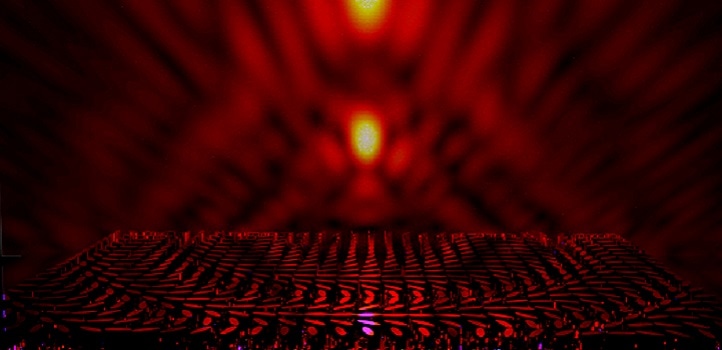Ultrathin nanostructured films with the ability to control the propagation of light offer a means to incorporate optical components into portable and wearable electronics.
 A metasurface comprises an array of nanofins and behaves like an ultrathin bifocal lens. (Image credit: 2019 KAUST)
A metasurface comprises an array of nanofins and behaves like an ultrathin bifocal lens. (Image credit: 2019 KAUST)
Scientists from KAUST have developed an easy method to control the behavior and performance of ultrathin nanostructured films by twisting a stack of such films.
A surface having a pattern of nanometer-scale structural arrangement could transform the properties of light that travels through it. Every element in the arrangement acts as a very small antenna that could control the local phase of light.
This means that the relative position of the light wave is in its oscillatory cycle. Such ultrathin layers are known as metalenses as they can focus light similar to a traditional, although much thicker, glass lens, while being more effective.
This technology can arbitrarily shape the light pixel by pixel, which is impossible for conventional lenses because of fabrication limitations. The metalens technology has the potential to replace the huge lens assemblies used in professional reflex cameras with a lens as thin as a postcard.
Ronghui Lin, Graduate Student, KAUST
It is difficult to develop multifunctional metalenses owing to their restricted efficiency. However, this could be achieved by a feasible way of stacking the metalenses. Consequently, Lin and his supervisor, Xiaohang Li, found that the new phenomenon can be achieved through the stacking of metalenses.
The researchers found that the surface of a metalens was covered by an array of cylinders or fins with an elliptical cross section. When the relative orientation of these fins is varied, the lens contributes a geometric phase to incoming circularly polarized light.
Consider the rotation of the hands of a clock, which return to the same place every day. The rotation angle of these nanofins works in a similar manner. When light passes through these structures, its phase or ‘time’ is changed.
Ronghui Lin, Graduate Student, KAUST
The degree of change relies on the nanofin rotation. This is a robust tool for controlling circularly polarized light.
Lin and Li used a mathematical method known as finite-difference time-domain simulations to model light propagation in a metalens system consisting of two stacked phase elements. Their findings revealed that they can observe a phenomenon similar to the Moiré effect when the relative arrangement of the two layers was twisted. They used this phenomenon to design a bifocal metalens with controllable intensity ratio and focal length.
“We believe this multilayer metalens architecture could also apply to other systems and achieve more complicated functionalities,” stated Lin.
Source: https://www.kaust.edu.sa/en

